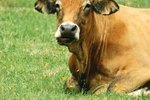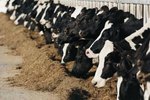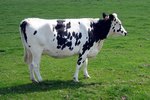A cow can suffer from several forms of prolapse, including vaginal, uterine or rectal. A prolapse occurs when tubal tissue turns inside out and hangs out of the body. While vaginal and uterine prolapses mainly occur in pregnant cows, rectal prolapses can occur in calves and bulls as well.
Problems
A prolapse is recognizable by the appearance of pink tissue protruding from the rear end of the cow, below the tail. Because this mass of uterine, vaginal or rectal tissue is outside of the body when it normally would be inside the body, a variety of issues can result. These include swelling, drying and damaging of the tissue that can lead to health problems such as infections and permanent damage to the area.
Recovery
Cattle that are treated for a prolapse as soon as possible by a veterinarian can have a full recovery from the condition. Most often the prolapsed tissue is replaced and sutures are used to keep it in the necessary area until it has a chance to heal. Depending on the condition of the animal as well as the tissue, they may need to go on a regimen of antibiotics as well. While rectal and uterine prolapses may be a one-time occurrence, a cow that experiences a vaginal prolapse connected to a pregnancy or birthing a calf may suffer one again the next time she breeds.
Breeding
A cow that experiences a prolapse should not be bred again as they can happen more than once. While cattle may only have a rectal prolapse once in their lifetime, the issue may be a hereditary trait that they can pass on to their offspring. Owners may not want to breed them as they could end up with multiple cows that suffer from prolapses.
Uterine
Cows that suffer from a uterine prolapse must have immediate veterinary attention or they could bleed to death internally from ruptured arteries just from moving around. This type of prolapse occurs within days of giving birth as the uterus is pulled through the body along with the calf. However, though this form is very serious, if healed correctly it is possible for a cow to breed again and not necessarily suffer the condition the next time she calves.
References
Writer Bio
Melissa Voelker has been a professional writer since 2002. She works full time at a TV station in the commercial traffic department and also writes for Paperbackreader.com and Pinkraygun.com. Her articles have appeared in "Listen," "The Spokesman Review" and "Freepress Houston."





